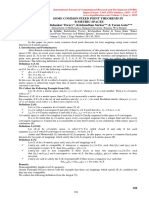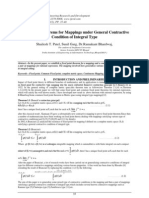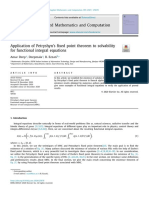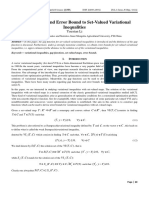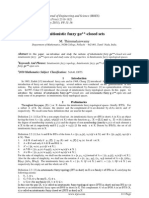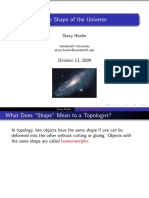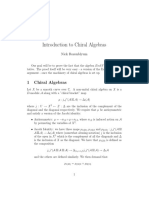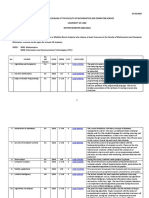A Common Fixed Point Theorems in 2-Metric Spaces Satisfying Integral Type Implicit Relation
A Common Fixed Point Theorems in 2-Metric Spaces Satisfying Integral Type Implicit Relation
Uploaded by
admin2146Copyright:
Available Formats
A Common Fixed Point Theorems in 2-Metric Spaces Satisfying Integral Type Implicit Relation
A Common Fixed Point Theorems in 2-Metric Spaces Satisfying Integral Type Implicit Relation
Uploaded by
admin2146Original Title
Copyright
Available Formats
Share this document
Did you find this document useful?
Is this content inappropriate?
Copyright:
Available Formats
A Common Fixed Point Theorems in 2-Metric Spaces Satisfying Integral Type Implicit Relation
A Common Fixed Point Theorems in 2-Metric Spaces Satisfying Integral Type Implicit Relation
Uploaded by
admin2146Copyright:
Available Formats
International Journal of Computing and Corporate Research
IJCCR India
1
A COMMON FIXED POINT THEOREMS IN 2-
METRIC SPACES SATISFYING INTEGRAL TYPE
IMPLICIT RELATION
Deo Brat Ojha
R.K.G.I.T. Ghaziabad,U.P.(INDIA)
Abstract
The aim of this paper is to prove some common fixed point theorems in 2- Metric
spaces for two pairs of weakly compatible mapping satisfying integral type implicit
relation. Our main result improves and extends several known results.
Keywords
2-Metric spaces, fixed point, weakly compatible mappings, compatible mappings, and
implicit relation.
2000 AMS Subject Classification: 54H25,47H10.
1. Introduction
2- metric space concept was developed by Gahler[1,2,3]. On the way of
development, a number of authors have studied various aspects of fixed point theory
in the setting of 2-metric spaces. Iseki [4,5] is prominent in this literature which also
include cho et.al.[6], Imdad et.al.[7],Murthy et.al.[8],Naidu and Prasad [9], Pathak
et.al. [10]. Various authors [11,12,13] used the concepts of weakly commuting
mappings compatible mappings of type(A) and (P) and weakly compatible mappings
of type(A) to prove fixed point theorems in 2-metric space.
Commutativity of two mappings was weakened by Sessa [14] with weakly
commuting mappings. Jungck[15] extended the class of non-commuting mappings by
compatible mappings,(further Jngck & Rhodes)[16] ,Jachymski[17] ,Pant[18],
Papa[19], Aliouche et.al.[20],Imdad et.al.[21], Abu-Donia & Atia[22],Popa et.al.[23]
and others.
2. Preliminaries
Let X be a nonempty set. A real valued function d on X
3
is said to a 2-metric if
(D
1
) to each pair of distinct points , x y in X, there exits a point
( , , ) 0, Z X suchthat d x y z
(D
2
) 0 ) , , ( = z y x d when at least two of , , x y z are equal,
(D
3
) ), , , ( ) , , ( ) , , ( x z y d y z x d z y x d = =
(D
4
) ( , , ) ( , , ) ( , , ) ( , , ) , , , . d x y z d x y u d x u z d u y z for all x y z u X + +
The function d is called a 2-metric on set X where as the pair ( , ) X d stands for 2-
metric space, geometrically a 2-metric ( , , ) d x y z represents the area of a triangle
with their vertices as , x y and z , As property of 2-metric d is a non-negative
continuous function in any one of its three arguments but it need not be continuous in
two arguments.
International Journal of Computing and Corporate Research
IJCCR India
2
Definition 2.1 A sequence { }
n
x in a 2-metric space ( , ) X d is said to be convergent
to a point , x X denoted by lim , lim ( , , ) 0 .
n n
x x if d x x z for all z X = =
Definition 2.2
A sequence { }
n
x in a 2-metric space ( , ) X d is said to be Cauchy sequence if
lim ( , , ) 0 .
n m
d x x z for all z X =
Definition 2.3
A 2-metric space ( , ) X d is said to be complete if every Cauchy sequence in X is
convergent.
Remark 2.1[9]
Generally a convergent sequence in a 2-metric space ( , ) X d need not be Cauchy but
every convergent sequence is Cauchy sequence whenever 2-metric d is
continuous. A 2-metric d on a set X is said to be weakly continuous if every
convergent sequence under d is Cauchy.
Definition 2.4[8]
Let S and T be mappings from a 2-metric space ( , ) X d into itself. The mappings S
and T are said to be compatible if ( ) lim , , 0
n n
d STx TSx z =
, for all z X whenever {
n
x } is a sequence is X such that lim lim
n n
Sx Tx t = =
for some t X .
Definition 2.5[22]
A pair of self mappings S and T of a 2-metric space ( , ) X d is said to be weakly
compatible if ( ) . Sx Tx for some x X implies STx TSx = =
Definition 2.6[8]
Let (S,T) be a pair of self mappings of a 2-metric space ( , ) X d .The mapping S and T
are said to be compatible of type (A) if
( ) ( ) lim , , lim , , 0 ,
n n n n
d TSx SSx z d STx TTx z for all z X = =
When ever { }
n
x is a sequence in X such that lim lim .
n n
Sx Tx t for some t X = =
Definition 2.7[10]
Let (S,T) be a pair of self mappings of a 2-metric space ( , ) X d .Then the pair (S ,T) is
said to be weakly compatible of type (A) if
( ) ( ) lim , , lim , ,
n n n n
d STx TTx z d TSx TTx z and
( ) ( ) lim , , lim , , 0 ,
n n n n
d TSx SSx z d STx SSx z for all z X = = where { }
n
x is a
sequence in X such that lim lim .
n n
Sx Tx t for some t X = =
On the other hand Branciari [24] gave a fixed point result for a single mapping
satisfying an analogue of Banachs contraction principle which is stated as follows,
Theorem 2.1[24]
Let ( , ) X d be a complete metric space, [0,1), : c T X X a mapping such that, for
each , , x y X
( , ) ( , )
0 0
( ) ( )
d Tx Ty d x y
f t dt c f t dt
International Journal of Computing and Corporate Research
IJCCR India
3
where
+ +
R R f : is a Lebesgue integrable mapping which is summable, non-
negative and such that for each . 0 > s
>
s
dt t f
0
. 0 ) ( then T has a unique fixed point
z X such that, for each , lim .
n
n
x X T x z =
This result was further generalized by Abbas and Rhoades [25], Aliouche
[26],Gairola and Rawat[27],Kumar et.al [28],Bryant[29].
3. Implicit Relations
Let G be the set of all continuous functions
+ +
R R G
6
: satisfying the following
conditions: (G
1
) G is decreasing in variables t
2
.t
6
(G
2
) There exist ( ) 0,1 , 0 h such that for u v with
(G
a
): ( )
( )
+
0 , , , , ,
0
. , 0
v u u v v u G
v h u implies dt t ,
(G
b
): ( )
( )
+
v u v u v u G
v h u implies dt t
, 0 , , , ,
0
. , 0
(G
3
) ( )
( ) , ,0,0, ,
0
0, 0
G u u u u
t dt for all u > >
Let be the family of such functions G and R R
+
: is a Lebesgue- integrable
mapping which is summable.
Example 3.1 Let ( ) ( )
)
`
+ =
6 5 4 3 2 1 6 2 1
2
1
, , , max ,...... , t t t t t p t t t t F
where (0,1) p and ( )
( ) ( ) t
t
Cos
t
t
+ +
=
1 4
3
.
1 4
3
2
. for all t in R
+
4. Main Results
Example 4.1 Define ( ): ,...... ,
6 2 1
t t t G as R R
+
6
( ) ( )
1 2 6 1 2 3 4 5 6
1
, ,... max , , ,
2
G t t t t t t t t t
| |
= +
`
|
) \
,Where : R R
+ +
is an
increasing upper semi continuous function with ( ) ( ) 0 0 and t t = < for each t >
0 and R R
+
: is a Lebesgue integrable mapping which is summable.
(G
1
) : obvious
(G
2
) : (G
a
):
( )
( )
( ) ( ) { }
( ) { }
, , , , ,0
2
0
3
3 3
. 0, if . 0,
4 1 4 1
4 1
G u v v u u v u u
t
Cos dt u v then Sin
t u u
t
+
+ +
+
Which implies, ( ) ( ) 0 u u u u u = = < , which is a contradiction hence,
u v and u hv < , ( ) 0,1 where h .
(G
2
):(G
b
) : Similarly argument in (G
a
).
International Journal of Computing and Corporate Research
IJCCR India
4
G
3
:
( )
( )
( ) ( ) { }
( ) { }
, ,0,0, ,
2
0
3
3 3
. 0, : , 0,
4 1 4 1
4 1
G u u u u u u
t
Cos dt So Sin
t u u
t
> >
+ +
+
for all 0 u >
Remark 4.1 ( )
( ) ( ) t
t
Cos
t
t
+ +
=
1 4
3
.
1 4
3
2
is negative for ( ) 2, t positive for
( ) 0, 2 t and vanishes at t = 2.
Our aim in this article is to prove a common fixed theorem for a quadruple of
mappings satisfying certain integral type implicit relations in 2-metric space. Which
provides the tool for finding the existence of common fixed point for two pairs of
weakly compatible mappings.
Now we state and prove our main result.
Proposition 4.1
Let ( , ) X d be a 2- metric space and X X : T S, B, A, be four mapping satisfying
the condition
( )
( ) ( ) ( ) ( ) ( ) ( ) ( )
a Ax Ty d a By Sx d a By Ty d a Ax Sx d a Ty Sx d a By Ax d G
dt t
, , , , , , , , , , , , , , , , ,
0
0 (4.1)
for all , x y X and for all a X ,where G satisfies propertiesG
1
,G
2
(G
a.
),G
2
(G
b.
) and
G
3
with R R
+
: is a Lebesgue integrable mapping which is summable.
The A,B,S and T have at most one common fixed point.
Proof :
Let on contrary that A,B,S and T have two common fixed points u and v such that
v u . Then by ( 4,1 ), we have
( )
( ) ( ) ( ) ( ) ( ) ( ) ( )
a Au Tv d a Bv Su d a Bv Tv d a Au Su d a Tv Su d a Bv Au d G
dt t
, , , , , , , , , , , , , , , , ,
0
0
or ( )
( ) ( ) ( ) ( ) ( ) , , , , , ,0,0, , , , , ,
0
0, .
G d u v a d u v a d u v a d v u a
t dt for all a X
which contradicts (G
3
).
This provides u v = .
Let A,B,S and T be mappings from a 2-metric space ( , ) X d into itself satisfying the
following condition : ( ) ( ) ( ) ( ) A X T X and B X S X (4.2)
Since ( ) ( ) A X T X , for arbitrary point
0
x X there exits a point
1
x X such that
1 0
Tx Ax = . Since ( ) ( ) B X S X , for the point
1
x . We can choose a point
2
x X such that
2 1
Sx Bx = and so on. Inductively, we can define a sequence { }
n
y in
X such that
2 2 2 1 2 1 2 1 2 2
: 0,1, 2,...
n n n n n n
y Ax Tx and y Ax Tx n
+ + + +
= = = = = (4.3)
Lemma 4.1 If A,B,S and T be mappings from a 2-metric space ( , ) X d into itself
which satisfy conditions (4.1) and (4.2), then
(a) ( )
1 2
, , 0
n n n
d y y y for every n N
+ +
= ;
International Journal of Computing and Corporate Research
IJCCR India
5
(b)
( )
, , 0 , , ,
i j k
d y y y for i j k N = where { }
n
y is a sequence described by
(4.3) and R R
+
: is a Lebesgue integrable mapping which is summable.
Proof (a) From (4.1)
( )
( ) ( ) ( )
( ) ( ) ( )
)
`
+ + + + + +
+ + + + + +
n n n n n n n n n
n n n n n n n n n
y Ax Tx d y Bx Sx d y Bx Tx d
y Ax Sx d y Tx Sx d y Bx Ax d
G
dt t
2 2 2 1 2 2 1 2 2 2 2 1 2 1 2
2 2 2 2 2 2 1 2 2 2 2 1 2 2 2
, , , , , , , ,
, , , , , , , , ,
0
0
or, ( )
( ) ( ) ( )
( ) ( ) ( )
)
`
+ + +
+ + + + +
n n n n n n n n n
n n n n n n n n n
y y y d y y y d y y y d
y y y d y y y d y y y d
G
dt t
2 2 2 2 1 2 1 2 2 1 2 2
2 2 2 1 2 2 2 2 2 2 1 2 2 2
, , , , , , , ,
, , , , , , , , ,
0
0
or, ( )
( ) ( ) { }
+ + + +
0 , 0 , 0 , , , , 0 , , ,
0
2 1 2 2 2 2 1 2 2 2
0
n n n n n n
y y y d y y y d G
dt t
or, ( )
( ) ( ) ( ) { }
+ + + + + +
n n n n n n n n n
y y y d y y y d y y y d G
dt t
2 1 2 2 2 2 1 2 2 2 2 1 2 2 2
, , , 0 , 0 , , , , 0 , , ,
0
0
yielding there by ( )
2 2 2 1 2
, , 0, .
n n n b
d y y y dueto G
+ +
= Similarly using (G
a
) we can
show that ( ) 0 , ,
1 2 2 1 2
=
+ n n n
y y y d thus it follows that ( ) 0 , ,
2 1
=
+ + n n n
y y y d for every
. n N
(b) For all . a X , let us suppose ( ) ,....... 2 , 1 , 0 , , ,
1
= =
+
n y y y d d
a n n n
first we shall
prove that { }
n
d is a non-deceasing sequence in R
+
, from (4.1), we have
( )
( ) ( ) ( )
( ) ( ) ( )
)
`
+ + + +
+ +
a Ax Tx d a Bx Sx d a Bx Tx d
a Ax Sx d a Tx Sx d a Bx Ax d
G
n n n n n n
n n n n n n
dt t
, , , , , , , ,
, , , , , , , , ,
0
2 1 2 1 2 2 1 2 1 2
2 2 1 2 2 1 2 2
0
or, ( )
( ) ( ) ( )
( ) ( ) ( )
)
`
+ +
+
a y y d a y y d a y y d
a y y d a y y d a y y d
G
n n n n n n
n n n n n n
dt t
, , , , , , , ,
, , , , , , , , ,
0
2 2 1 2 1 2 1 2 2
2 1 2 2 1 2 1 2 2
0
or, ( )
( ) ( ) ( ) ( )
( ) ( ) ( )
)
`
+ +
+ +
+ +
0 , , , , , , ,
, , , , , , , , , , , ,
0
2 1 2 2 1 2 2 1 2 1 2
1 2 2 2 1 2 2 1 2 1 2 2
0
a y y d a y y d y y y d
a y y d a y y d a y y d a y y d
G
n n n n n n n
n n n n n n n n
dt t
or, ( )
( ) ( ) ( ) ( )
( ) ( )
)
`
+
+
+ +
0 , , , , ,
, , , , , , , , , , , ,
0
1 2 2 1 2 1 2
1 2 2 2 1 2 2 1 2 1 2 2
0
a y y d a y y d
a y y d a y y d a y y d a y y d
G
n n n n
n n n n n n n n
dt t
Implying
2 2 1 2 1
( ( ))
n n n a
d hd d due to G
< Similarly using ) (
b
G , we have
2 1 2 n n
d hd
+
.Thus
n n
d d <
+1
for ,....... 2 , 1 , 0 = n .It is easy to verify
( )
, , 0 , , .
i j k
d y y y for i j k N =
Lemma 4.2-Let { }
n
y be a sequence in a 2-metric space ( , ) X d describe by(4.3),
then ( ) 0 , ,
1
=
+
a y y d
n n
For all a X .
Proof: As in Lemma 4.1 we have
2 1 2 n n
d hd
+
and
2 2 1 n n
d hd
. Therefore we get
0
n
n
d h d . So . 0 lim ) , , ( lim
1
= =
+ n n n
d a y y d
International Journal of Computing and Corporate Research
IJCCR India
6
Lemma 4.3-Let A,B,S and T be mapping from a 2-metric space ( , ) X d into itself
which satisfy conditions (4.1) and (4.2). Then the sequence { }
n
y describe by (4.3) is
a Cauchy sequence. Where R R
+
: is a Lebesgue-integrable mapping which is
summable.
Proof: Since 0 ) , , ( lim
1
=
+
a y y d
n n
by Lemma 4.2, it is sufficient to show that a
sequence { }
n
y
2
or { }
n
y is a Cauchy sequence in X . Suppose that { }
n
y
2
is not a
Cauchy sequence in X , then for every 0 > there exits a X and strictly increasing
sequences { } { }
k k
n m , of positive integer such that
( ) ( )
2 1 2 2 2 2
, , , ,
k k k k
k k n m n m
k n m with d y y a and d y y a
< < . We can obtain
( ) = a y y d
k k
m n
, , lim
2 2
, ( ) =
a y y d
k k
m n
, , lim
1 2 2
, ( ) =
+
a y y d
k k
m n
, , lim
2 1 2
,and
( ) . , , lim
1 2 1 2
=
+
a y y d
k k
m n
Now using 4.1 we have,
or
let
, , have we n
( )
( )
, , 0 , 0 , ,
0
. 0
G
t
Which is a contradiction to (G
3
). Therefore { }
n
y
2
is a Cauchy sequence.
Theorem 4.1-Let A,B,S and T be mappings of a 2-metric space ( , ) X d and
R R
+
: is a Lebesgue integrable mapping which is summable satisfy conditions
(4.1) and (4.2). If one of ( ) ( ) ( ) ( ) X T or X S X B X A , is a complete subspace of X,
then
I. The pair ( A,S) has a point of coincidence.
II The pair ( B,T) has a point of coincidence.
Moreover, A,S,B and T have a unique common fixed point provided both the pairs
( A,S) and ( B,T) are weakly compatible.
Proof:Let { }
n
y be a sequence defined by (4.3). By Lemma (4.3), { }
n
y is a Cauchy
sequence in X . Suppose that ( ) X S is a complete subspace of X ,then the
subsequence { }
1 2 + n
y which is contained in ( ) X S must have a limit z in ( ) X S . As
{ }
n
y is a Cauchy sequence containing a convergent subsequence{ }
1 2 + n
y , therefore
{ }
n
y also converges implying the convergence of the subsequence
{ }
n
y
2
, i.e.,
1
2 2 1 2 1 2 2
lim lim lim lim . ( ), .
n n n n
Ax Bx Tx Sx z let u S z then Su z
+ + +
= = = = = If
z Au , then using (4.1),we have ,
( )
( ) ( ) ( )
( ) ( ) ( )
)
`
+ + + +
+ +
a Ax Tx d a Bx Sx d a Tx Bx d
a Ax Sx d a Tx Sx d a Bx Ax d
G
k
m
k
n
k
n
k
m
k
n
k
n
k
m
k
m
k
n
k
m
k
n
k
m
dt t
, , , , , , , ,
, , , , , , , , ,
0
2 1 2 1 2 2 1 2 1 2
2 2 1 2 2 1 2 2
0
( )
( ) ( ) ( )
( ) ( ) ( )
)
`
+ +
+
a y y d a y y d a y y d
a y y d a y y d a y y d
G
k
m
k
n
k
n
k
m
k
n
k
n
k
m
k
m
k
n
k
m
k
n
k
m
dt t
, , , , , , , ,
, , , , , , , , ,
0
2 2 1 2 1 2 1 2 2
2 1 2 2 1 2 1 2 2
0
International Journal of Computing and Corporate Research
IJCCR India
7
( )
( ) ( ) ( )
( ) ( ) ( )
)
`
a Au Tx d a Bx Su d a Bx Tx d
a Au Su d a Tx Su d a Bx Au d
G
n n n n
n n
dt t
, , , , , , , ,
, , , , , , , , ,
0
1 2 1 2 1 2 1 2
1 2 1 2
0
let , n it gives, ( )
( ) ( ) ( ) ( ) ( ) ( ) { }
a Au z d a z z d a z z d a Au z d a z z d a z Au d G
dt t
, , , , , , , , , , , , , , , , ,
0
0
hence, therefore ( ) , , 0 d z Au a for all a X = ( due to (G
b
)),hence z Au Su = = .
Since ( ) ( )
1
, ( ) . A X T X there exists v T z such that Tv z
< =
By (4.1), we have.
( )
( ) ( ) ( ) ( ) ( ) ( ) { }
a Au Tv d a Bv Su d a Bv Tv d a Au Su d a Tv Su d a Bv Au d G
dt t
, , , , , , , , , , , , , , , , ,
0
0
or ( )
( ) ( ) ( ) { }
0 , , , , , , , 0 , 0 , , ,
0
0
a Bv z d a Bv z d a Bv z d G
dt t
Hence, therefore ( ) , , 0 d z Bv a for all a X = ( due to (G
a
).hence z Bv = .So,
z Tv Bv Su Au = = = = , which establishes (i) and (ii).
If one assumes that T(X) is a complete subspace of X, then analogous arguments
establish (i) and (ii). The remaining two cases also pertain essentially to the previous
cases. If A(X) is complete, then ( ) ( ). z B X S X Thus in all cases (i) and (ii) are
completely established.
Since A and S are weakly compatible and z Su Au = = ,then ASu SAu = ,which
implies Az Sz = . By (4.1) we have
( )
( ) ( ) ( ) ( ) ( ) ( ) { }
a Az Tv d a Bv Sz d a Bv Tv d a Az Sz d a Tv Sz d a Bv Az d G
dt t
, , , , , , , , , , , , , , , , ,
0
0
or ( )
( ) ( ) ( ) ( ) { } , , , , , ,0,0, , , , , ,
0
0
G d Az z a Az z a d Az z a d Az z a
t dt
A Contradiction to (G
3
) if ( ) 0 , , > a z Az d . Hence Sz Az z = = . Since B and T are
weakly compatible and B T z v v = = then compatible and BT TB v v = which
implies Tz Bz = Again By (4.1) we have,
( )
( ) ( ) ( ) ( ) ( ) ( ) { }
a Az Tz d a Bz Sz d a Bz Tz d a Az Sz d a Tz Sz d a Bz Az d G
dt t
, , , , , , , , , , , , , , , , ,
0
0
or ( )
( ) ( ) ( ) { }
a Bz z d a Bz z d a Bz z d a Bz z d G
dt t
, , , , , , 0 , 0 ), , , ( , , ,
0
0
A Contradiction to (G
3
) if ( ) 0 , , > a Bz z d . Hence Tz Az z = = . Therefore
Tz Bz Sz Az z = = = =
Which shows that z is a common fixed point of the mappings A,B,S and T. in the
view of proposition (4.1), z is the unique common fixed point of the mappings A,B,S
and T.
Example 4.2[23]
Let } , , , { d c b a X = be a finite set of R
2
equipped with natural area function on X
3
.
Where ) 1 , 0 ( ), 0 , 8 ( ), 0 , 4 ( ), 0 , 0 ( = = = = d and c b a . Then clearly ( ) d X , is a 2-
metric space. Define the self mappings A,B,S and T on X as follows,
International Journal of Computing and Corporate Research
IJCCR India
8
and b Sd c Sc a Sb Sa a Bd Bc a Bb Ba b Ad Ac a Ab Aa = = = = = = = = = = = = , , , , , ,
c Td b Tc a Tb Ta = = = = , , , and R R
+
: is a Lebesgue integrable mapping
which is summable. Notice that
( ) { } { } ( ) ( ) { } { } ( ) also X S c b a b a X B and X T c b a b a X A = = = = , , , , , , ,
( ) ( ) ( ) ( ) X T and X S X B X A , , are complete subspace of X. the pair (A,S) is weakly
compatible but not commuting as a. SAc b ASc = = where as the pair (B,T) is
commuting and hence weakly compatible.
Define ( ): ,...... ,
6 2 1
t t t G as R R
+
+
6
( ) ( )
|
|
\
|
)
`
+ =
6 5 4 3 2 1 6 2 1
2
1
, , , max ,... , t t t t t p t t t t G
Then conditions of theorem (4.1) is satisfied with
2
1
= p . Thus all the conditions of
theorem 4.1 are satisfied and ) 0 , 0 ( = a is a unique common fixed point of A,B,S and
T and both pairs have two points of coincidence namely ) 0 , 4 ( ) 0 , 0 ( = = b and a .
Theorem4.2-Let A,B,S and T be mappings from a 2-metric space( ) d X , into itself.
If inequality (4.1) holds for all , , x y a X then
( ) ( ) ( ) ( ) ( ) ( ) ( ) ( ) F S F T F A F S F T F B = and R R
+
: is a
Lebesgue integrable mapping which is summable.
Proof :Let ( ) ( ) ( ) ( ) x F S F T F A .then using (4.1), we have
( )
( ) ( ) ( ) ( ) ( ) ( ) { }
a Ax Tx d a Bx Sx d a Bx Tx d a Ax Sx d a Tx Sx d a Bx Ax d G
dt t
, , , , , , , , , , , , , , , , ,
0
0
or ( )
( ) ( ) ( ) { } , , ,0,0, , , , , , ,0
0
0
G d x Bx a d x Bx a d x Bx a
t dt
Hence ( ) , , 0 ( ). .
a
d x Bx a a X duetoG Therefore x Bx = =
Thus ( ) ( ) ( ) ( ) ( ) ( ) ( ) ( ) B F T F S F A F T F S F . Similarly using (G
b
) we
can show that,
( ) ( ) ( ) ( ) ( ) ( ) ( ) ( ) A F T F S F B F T F S F . Now with theorem 4.1 and 4.2,
we can follows.
Theorem 4.3- Let { }
{ } 0
,
i N
A B T
be mappings of a 2-metric space( ) d X , into itself
such that,
I. ( ) ( ) ( ) ( ),
0
X B X T and X A X T
i
II The pairs ( ) ( ) ( )
0
, ,
i
T B and T A i N are weakly compatible.
III The inequality
( )
( ) ( ) ( ) ( ) ( ) ( ) { }
a x T By d a y T x T d a y T By d a x T Ax d a By Ax d a y T x T d G
i i i
dt t
, , , , , , , , , , , , , , , , ,
0
0 0 0 0
0
where R R
+
: is a Lebesgue integrable mapping which is summable, for each
, , , X a y x , . i N where G ( as example 4.1)
International Journal of Computing and Corporate Research
IJCCR India
9
Then A,B and { }
{ } 0
i
i N
T
have a unique common fixed point in X provided one of
0
( ), ( ) or ( ) A X B X T X is a complete subspace of X .
Now as an application of theorem 4.1, we prove an integral analogue of Bryant [31]
type generalized common fixed point theorem for four finite families of self
mappings, which is as follows:
Theorem 4.4 Let { }
1 2
, ,....., ,
m
A A A { }
1 2
, ,....., ,
n
B B B
{ }
1 2
, .....,
p
S S S and
{ }
1 2
, .....,
q
T T T be four finite families of self mappings on a 2-metric
space( ) d X , with
1 2
, ,....., ,
m
A A A A =
1 2
, ,....., ,
n
B B B B =
1 2
, .....,
p
S S S S = and
1 2
, .....,
q
T T T T = so that Let A,B,S and T satisfy conditions (4.1) and (4.2) and
R R
+
: is a Lebesgue integrable mapping which is summable, If one of
( ) ( ) ( ) ( ) X T or X S X B X A , is a complete subspace of X, then
I. The pair ( A,S) has a point of coincidence.
II. The pair ( B,T) has a point of coincidence.
Moreover, if ,
i j j i
A A A A = ,
k l l k
S S S S = ,
s r r s
B B B B = ,
u v v u
T T T T = ,
i k k i
AS S A =
r v v r
and B T T B = For all { }
1
, 1, 2,..... , i j I m = , k { }
2
1, 2,..... , l I p =
{ } { }
3 4
, 1, 2,..... , 1, 2,..... r s I n and u v I q = = . Then for all
( )
1 2 3 4
, , i I k I r I and v I , ,
i r k v
A B S and T have a common fixed point.
Proof :The conclusions (i) and (ii) are immediate as A,B,S and T satisfy all the
conditions of Theorem 4.1. In view of pair wise commutativity of various pairs of
families { } { } T B and S A , , ,the weak compatibility of pairs (A,S) and (B,T) are
immediate. Thus all the condition of theorem 4.1 ( for mapping A,B,S and T) are
satisfied ensuring the existence the unique common fixed point, say w. Now we need
to show that w remains the fixed point of all the component maps. For this consider
( ) ( ) ( ) ( ) ( ) ( ) ( )( )
1 2 1 2 1 1 2 1
, ,.... , ,.... , ,....
i m i m m i m i m
A Aw A A A A w A A A A A w A A A A A w
= = =
( ) ( ) ( ) ( ) ( ) ( )
1 2 2 1 1 2 2 1
, ,.... , ,.... ......
m m i m m i m m
A A A A A A w A A A A A A w
= = =
( ) ( ) ( ) . ,.... , ,.... ,
3 2 1 3 2 1
w A A A w A A A A A w A A A A A
i w i m i m i
= = = =
Similarly, we can show that
( ) ( ) ( ) ( ) ( ) ( )
( ) ( )
, ,
,
k k k k k k i i
i r r r
A S w S Aw S w S S w S Sw S w S Aw A Sw
Aw B B w B Bw B w
= = = = =
= = =
( ) ( ) ( ) ( ) ( ) ( ) , ,
v v v v v v r r r
B T w T Bw T w T T w T Tw T w and T B w B Tw B w = = = = = =
which show that ( for all i, k, r and v) w A
i
and w S
k
are other fixed points of the
(A,S) where as w B
r
and w T
v
are other fixed points of the pair (B,T). Now in the
view of uniqueness of the fixed point of A,B,S and T ( for all i, k, r and v), we can
write , w T w B w S w A w
v r k i
= = = = which shows that w is a common fixed point of
. , , , , v and r k i all for T and B S A
v r k i
International Journal of Computing and Corporate Research
IJCCR India
10
By setting
1 2 1 2 1 2
.... , .... , ....
m n p
A A A A B B B B S S S S = = = = = = = = = ,
1 2
....
q
and T T T T = = = one can deduces the following corollary for various iterates
of A,B,S and T which can also be treated as generalization of Theorem 4.1 .
Corollary 4.1
Let (A,S) and (B,T) be two commuting pairs of self mappings of 2-metric space
( ) d X , ,such that ) ( ) ( ) ( ) ( X S X B and X T X A
p n q m
, with R R
+
: is a
Lebesgue integrable mapping which is summable, Satisfy
( )
( ) ( ) ( ) ( ) ( ) ( ) { }
a x A y T d a y B x S d a y B y T d a x A x S d a y T x S d a y B x A d G
m q n p n q m p q p n m
dt t
, , , , , , , , , , , , , , , , ,
0
0 (4.4)
for all , , , . x y X and for all a X where G If one of
) ( ) ( ), ( ), ( X S or X B X T X A
p n q m
is a complete subspace of , then A,B,S and T have
a unique common fixed point.
Example 4.3:Consider } , , , { d c b a X = is a finite subset of R
2
with
), 0 , 4 ( ), 0 , 0 ( = = b a ), 0 , 8 ( = c ) 1 , 0 ( = d and equipped with natural area function
on X
3
. Define self mappings A,B,S and T on X with R R
+
: is a Lebesgue
integrable mapping which is summable, as follows.
, , , ,
,
Aa Ab Ad a Ac b Ba Bb Bc a Bd b
and Sa Sb a Sc Sd b and
= = = = = = = =
= = = =
a Td Tc Tb Ta = = = = ,W
e see that { } { } ) ( ) ( ) ( ) (
2 2 ' 2
X S a X B and X T a X A = = = = and the pairs (A,S) and
(B,T) are commuting.
Define ( ): ,...... ,
6 2 1
t t t G as R R
+
+
6
( ) ( )
|
|
\
|
)
`
+ =
6 5 4 3 2 1 6 2 1
2
1
, , , max ,... , t t t t t p t t t t G ,
where 0 1 p < < .
Then, we verify that contraction condition 4.1 is satisfied for
( ) ( ) 0 , , , , , ,
2 2 ' 2 2 2
= = z a a d z y B x A d as T and S B A for all , , x y z X . Thus all the
condition of corollary 4.1 are satisfied for
2 2 2
, , S B A and T and hence the mappings
A,B,S and T have a unique common fixed point .
Even if, Theorem 4.1 is not applicable in the content of this example, as
( ) { } { } ( ) { } { } , ( ) , , ( ) A X a b a T X and B X a c a b S X = = = =
/ /
. Moreover, the
contraction condition (4.1) is not satisfied for A,B,S and T. To eliminate this, we
consider the case,when { } p = = = 1,0,0,0,1 max p 1 get we a, y and c x
which is a contradiction to the fact that 1 < p . Thus corollary 4.1 is slightly different
to Theorem4.1.
REFERENCES
[1]. S. Gahler, 2-metrische Raume und iher topologische structur.Math.Nachr,26
(1963) , 115-148.
[2]. S. Gahler, Uber die uniforisierbarket 2-metrisches Raume, Math.Nachr.,28
(1965), 235-244.
International Journal of Computing and Corporate Research
IJCCR India
11
[3]. S. Gahler, Zur geometric 2-metrischer Raume, Revue Roumaine, Math. Pures
Appl.11(1966),665-667.
[4]. K. Iseki, Fixed point theorem in 2-metric spaces, Math. Sem. Notes,Kobeuni 3
(1) (1975) ,133-136.
[5]. K. Iseki, P.L. Sharma, B.K. Sharma, Contraction type mapping on 2-metric
space, Math.Japonica, 21(1976),67-70.
[6]. Y.J.Cho,M.S. khan and S.L.Singh, Common fixed points of weakly commutating
mappings, univ.Novom Sadu, Sb.Rd. Prirod-mat.Fak.Ser.Mat.,18(1)(1988),129-142.
[7]. M. Imdad, M.S. Kumar and M.D. Khan, A Common fixed point theorem in 2-
metric spaces . Math., Japonica 36(5)(1991), 907-914.
[8]. P.P. Muthuy, S.S. Chang , Y.J.Cho and B.K.Sharma, Compatible mappings of
type (A) and common fixed point theorems , Kyungpook Math, J.,32(2) (1992), 203-
216.
[9]. S.V.R. Naidu and J.R. Prasad, Fixed point theorems in 2-metric spaces,Indian J.
Pure Appli.Math.17(8)(1986),974-993.
[10]. H.K. Pathak, S.M. kang and J.H. Back, Weak compatible mappings of Type (A)
and common fixed points, Kyungbook Math.J.,35(1995),345- 359.
[11]. Y.J. Cho., Fixed points for compatible mappings of type (A), Math. Japonica,
38(3) (1993),497-508.
[12]. D. Tan, Z. Liu and J. K. Kim, Fixed points for compatible mappings of Type
(P)n 2-metric spaces, Nonlinear Funct. Anal. Appl., 8(2)(2003),215-232.
[13].W.Z. Wang, Common fixed points for compatible mappings of type (A) in 2-
metric spaces, Honam Math. J., 22 (2000) , 91-97.
[14]. S.Sessa, On a weak commutativity condition in fixed point considerations,
Publ.Inst. Math. (Beograd),32 (46),(1982),146-153.
[15].G. Jungck, Fixed points for non continuous non self maps on non metric spaces,
Far East. J. Math. Sci., 4(2)(1996),199-215.
[16]. G. Jungck and B.E. Rhodes, Fixed points for set-valued functions without
continuity, Indian J. Pure Appl., 29(3)(1998),227-238.
[17]. J. Jachymski, Common fixed point theorems for some families of maps, Indian
J.Pure. appl. Math. 25(1995),925-937.
[18]. R. P .Pant, Common fixed point theorems of Sequences of
mappings,Ganita,47(1996), 43-49.
[19].V. Popa, Some fixed point theorems for compatible mappings satisfying an
implicit relation,Demonstratio Math,32(1)(1999), 157-163.
[20]. A. Aliouche and A Djoudi, A general Common fixed point theorem reciprocally
continuous mapping satisfying an implicit relation, AJMAA, 2(2)(2005),1-7.
[21]. M. Imdad,S. Kumar and M.S. Khan, Remarks on some fixed point theorems
satisfying implicit relations. Radovi Mat., 11(2002), 135-143.
[22]. H.M. Abu-Donia and H,A. Atia, Common fixed points theorem in 2-metric
spaces, Arabian J. Sci. Engg. (To appear).
[23]. V. Popa, M. Imdad and Javed Ali, Using Implicit relation to prove unified fixed
point theorems in metric and 2- metric spaces, Bulletin of The Malaysian
Mathematical Sciences, Accepted,1-19.
[24].A. Branciari, A Common fixed point theorem for mapping satisfying a general
condition of integral type. Int. J. Math. Sci. 29(9)(2002), 531-536.
International Journal of Computing and Corporate Research
IJCCR India
12
[25]. Mujahid Abbas and B.E. Rhoades, A Common fixed point theorem for hybrid
pairs of occasionally weakly compatible mappings satisfying a generalized
contractive condition of integral type., Fixed point theory and Applications 4 2007).
[26].A Aliouche, A Common fixed point theorem for weakly compatible mappings
in symmetric spaces satisfying a contractive condition of integral type. J.Math.
Anal.Appl. 322(2)(2006),796-802.
[27]. U.C. Gairola and A.S. Rawat, A fixed point theorem for integral type inequality.
Int. J. Math. Anal.2(15) 2008, 709-712.
[28]. S. Kumar, R. Chug and R. Kumar, Fixed point theorem compatible mappings in
satisfying a contractive condition of integral type, Sochow J. Math. 33 (2) (2007) ,
181-185.
[29]. V.W. Bryant, A remark on a fixed point theorem for iterated mappings.Amer.
Math. Monthly ,75(1968),399-400.
You might also like
- Evans PDE Solution Chapter 3 Nonlinear First-Order PDEDocument6 pagesEvans PDE Solution Chapter 3 Nonlinear First-Order PDEPubavaNo ratings yet
- Some Fixed Point Theorems in Metric and 2-Metric Spaces: S. Venkata Ratnam NaiduDocument12 pagesSome Fixed Point Theorems in Metric and 2-Metric Spaces: S. Venkata Ratnam NaiduTomi DimovskiNo ratings yet
- Fixed Point and Weak Commuting MappingDocument4 pagesFixed Point and Weak Commuting MappingInternational Journal of Research in Engineering and TechnologyNo ratings yet
- International Journal of Pure and Applied Mathematics No. 3 2015, 325-337Document14 pagesInternational Journal of Pure and Applied Mathematics No. 3 2015, 325-337Soumya DasguptaNo ratings yet
- Common Fixed Points For Weakly Compatible Maps: Renu Chugh and Sanjay KumarDocument7 pagesCommon Fixed Points For Weakly Compatible Maps: Renu Chugh and Sanjay Kumarjhudddar99No ratings yet
- Common Fixed Point Theorems in A Complete 2-Metric SpaceDocument9 pagesCommon Fixed Point Theorems in A Complete 2-Metric SpaceTomi DimovskiNo ratings yet
- 15 - Published PapersDocument11 pages15 - Published PapersMehwish QadirNo ratings yet
- Choudhary) - Metric SpacesDocument28 pagesChoudhary) - Metric SpacesKhmer ChamNo ratings yet
- Some Fixed Point Theorems For Expansion Mappings: A.S.Saluja, Alkesh Kumar Dhakde Devkrishna MagardeDocument7 pagesSome Fixed Point Theorems For Expansion Mappings: A.S.Saluja, Alkesh Kumar Dhakde Devkrishna MagardeInternational Journal of computational Engineering research (IJCER)No ratings yet
- Fixed Point Theorem For Mapping Satisfying A Contractive Condition of Integral Type in D-Metric SpacesDocument2 pagesFixed Point Theorem For Mapping Satisfying A Contractive Condition of Integral Type in D-Metric SpacesSTATPERSON PUBLISHING CORPORATIONNo ratings yet
- YoshidaDocument20 pagesYoshidavodanhvnNo ratings yet
- (29-35) A Unique Common Fixed Point Theorem Under Psi Varphi Contractive Condition in Partial Metric Spaces Using Rational ExpressionsDocument8 pages(29-35) A Unique Common Fixed Point Theorem Under Psi Varphi Contractive Condition in Partial Metric Spaces Using Rational ExpressionsAlexander DeckerNo ratings yet
- Fixed Point Theorems For Mappings Under General Contractive Condition of Integral TypeDocument6 pagesFixed Point Theorems For Mappings Under General Contractive Condition of Integral TypeIJERDNo ratings yet
- Nonlocal Fractional Evolution Inclusions of OrderDocument17 pagesNonlocal Fractional Evolution Inclusions of OrderSoumyajit GhoshNo ratings yet
- 2 6Document6 pages2 6Luis Alberto FuentesNo ratings yet
- Metric MasDocument36 pagesMetric MasAngel Daniel Barria ComicheoNo ratings yet
- Metric SpacesDocument21 pagesMetric SpacesaaronbjarkeNo ratings yet
- ResearchDocument4 pagesResearchAamir MukhtarNo ratings yet
- Some Common Fixed Point Theorem For Cone Metric Space: Shailesh T.Patel, Ramakant BhardwajDocument7 pagesSome Common Fixed Point Theorem For Cone Metric Space: Shailesh T.Patel, Ramakant BhardwajSTATPERSON PUBLISHING CORPORATIONNo ratings yet
- 1604 7332 1 PBDocument11 pages1604 7332 1 PBankitagarakotiNo ratings yet
- Stability of P Order Metric RegularityDocument7 pagesStability of P Order Metric RegularityHữu Hiệu ĐoànNo ratings yet
- 4381 14376 1 PBDocument21 pages4381 14376 1 PBsanjica_307519190No ratings yet
- Physics: Communications inDocument16 pagesPhysics: Communications inswh03751No ratings yet
- Linear Viscoelasticity: 5.1 Model EquationsDocument16 pagesLinear Viscoelasticity: 5.1 Model Equationsapi-3733260No ratings yet
- New Results On Occasionally Weakly Compatible Mappingsand Fixed Point Theorem in Fuzzy Metric Spaces Satisfying Integral Type InequalityDocument8 pagesNew Results On Occasionally Weakly Compatible Mappingsand Fixed Point Theorem in Fuzzy Metric Spaces Satisfying Integral Type InequalityinventyNo ratings yet
- QB Second OrderDocument9 pagesQB Second OrderprofjnapolesNo ratings yet
- 1 s2.0 S0723086916300913 MainDocument5 pages1 s2.0 S0723086916300913 MainRabaouiNo ratings yet
- S-Metric SpaceDocument9 pagesS-Metric Spacemuhammad imamNo ratings yet
- Existence of Almost Automorphic Solutions of Neutral Functional Differential EquationDocument8 pagesExistence of Almost Automorphic Solutions of Neutral Functional Differential Equationsghoul795No ratings yet
- Ber KaneDocument6 pagesBer KaneSamar AhmedNo ratings yet
- A Remark On The Existence of Positive Radial Solutions To A Hessian SystemDocument9 pagesA Remark On The Existence of Positive Radial Solutions To A Hessian SystemCovei Dragos-PatruNo ratings yet
- 11.a Focus On A Common Fixed Point Theorem Using Weakly Compatible MappingsDocument7 pages11.a Focus On A Common Fixed Point Theorem Using Weakly Compatible MappingsAlexander DeckerNo ratings yet
- Covariance Identities and Mixing of Random Transformation of The Wiener SpaceDocument11 pagesCovariance Identities and Mixing of Random Transformation of The Wiener SpaceKofi Appiah-DanquahNo ratings yet
- Pmath940-W2 Copy 7Document11 pagesPmath940-W2 Copy 7Annie LiNo ratings yet
- Applied Mathematics and Computation: Amar Deep, Deepmala, R. EzzatiDocument9 pagesApplied Mathematics and Computation: Amar Deep, Deepmala, R. EzzatiHo Nhat NamNo ratings yet
- Numerical Methods For Systems of Nonlinear Differential Functional EquationsDocument14 pagesNumerical Methods For Systems of Nonlinear Differential Functional EquationsMaz AmininNo ratings yet
- Engineering Journal Gap Functions and Error Bound To Set-Valued Variational InequalitiesDocument7 pagesEngineering Journal Gap Functions and Error Bound To Set-Valued Variational InequalitiesEngineering JournalNo ratings yet
- Greens TheoremDocument9 pagesGreens TheoremAnonymous KIUgOYNo ratings yet
- 10.1515 - Taa 2020 0102Document7 pages10.1515 - Taa 2020 0102ankitagarakotiNo ratings yet
- tmp31AF TMPDocument6 pagestmp31AF TMPFrontiersNo ratings yet
- International Journal of Mathematics and Statistics Invention (IJMSI)Document3 pagesInternational Journal of Mathematics and Statistics Invention (IJMSI)inventionjournalsNo ratings yet
- tmp34BA TMPDocument5 pagestmp34BA TMPFrontiersNo ratings yet
- IIT Kanpur PHD May 2017Document5 pagesIIT Kanpur PHD May 2017Arjun BanerjeeNo ratings yet
- Slides 1Document20 pagesSlides 1siNo ratings yet
- Exam 1 SDocument6 pagesExam 1 S292bpmNo ratings yet
- Semi Weakly Compatibility of Maps in Fuzzy Metric Space: Faculty, National Institute of Technology, Warangal, IndiaDocument6 pagesSemi Weakly Compatibility of Maps in Fuzzy Metric Space: Faculty, National Institute of Technology, Warangal, IndiaTJPRC PublicationsNo ratings yet
- Articol 1-1Document10 pagesArticol 1-1vrubio66No ratings yet
- Fixed Point Result in Menger Space With EA PropertyDocument6 pagesFixed Point Result in Menger Space With EA PropertyAlexander DeckerNo ratings yet
- Khatibzadeh 2015Document7 pagesKhatibzadeh 2015satitz chongNo ratings yet
- On The Global Controlable For Set Differential EquationsDocument13 pagesOn The Global Controlable For Set Differential EquationsNguyen Ha Duc ThinhNo ratings yet
- Dynamics and Stability For Katugampola Random FracDocument13 pagesDynamics and Stability For Katugampola Random FracimtiazNo ratings yet
- GATE Mathematics Paper-2007Document11 pagesGATE Mathematics Paper-2007RajkumarNo ratings yet
- Homework 1 Graduate Real AnalysisDocument4 pagesHomework 1 Graduate Real AnalysislordpersonNo ratings yet
- Trudinger's Inequality and Continuity For Riesz Potential of Functions in Orlicz Spaces of Two Variable Exponents Over Nondoubling Measure SpacesDocument18 pagesTrudinger's Inequality and Continuity For Riesz Potential of Functions in Orlicz Spaces of Two Variable Exponents Over Nondoubling Measure Spacessahlewel weldemichaelNo ratings yet
- Linear Stochastic Differential Equations With Anticipating Initial ConditionsDocument9 pagesLinear Stochastic Differential Equations With Anticipating Initial ConditionsaqszaqszNo ratings yet
- Some Coincidence and Fixed Point Results For Hybrid ContractionDocument14 pagesSome Coincidence and Fixed Point Results For Hybrid ContractionAlexander DeckerNo ratings yet
- B 39 FFFDocument25 pagesB 39 FFFTomáš RoubalNo ratings yet
- Resistance Forms, Quasisymmetric Maps and Heat Kernel EstimatesDocument30 pagesResistance Forms, Quasisymmetric Maps and Heat Kernel EstimatesJorge PachasNo ratings yet
- 1084-Article Text-4070-1-10-20141013Document17 pages1084-Article Text-4070-1-10-20141013Prasoon PandeyNo ratings yet
- International Journal of Computing and Corporate Research IJCCR IndiaDocument13 pagesInternational Journal of Computing and Corporate Research IJCCR Indiaadmin2146No ratings yet
- Project Mismanagement: Eight To Late: International Journal of Computing and Corporate Research IJCCR IndiaDocument8 pagesProject Mismanagement: Eight To Late: International Journal of Computing and Corporate Research IJCCR Indiaadmin2146No ratings yet
- International Journal of Computing and Corporate Research IJCCR IndiaDocument20 pagesInternational Journal of Computing and Corporate Research IJCCR Indiaadmin2146No ratings yet
- Balance Sheet of The Next Millennium - Perspective, Possibilities and ProblemsDocument7 pagesBalance Sheet of The Next Millennium - Perspective, Possibilities and Problemsadmin2146No ratings yet
- 16Document34 pages16admin2146No ratings yet
- A Radical Approach To Lebesgue's Theory of Integration Part2Document50 pagesA Radical Approach To Lebesgue's Theory of Integration Part2Bobo (bloble)No ratings yet
- Factor EmbeddableDocument2 pagesFactor EmbeddableColin NaturmanNo ratings yet
- ConnectednessDocument5 pagesConnectednessRAHUL CHOUDHARYNo ratings yet
- K (XL: andDocument3 pagesK (XL: andEpic WinNo ratings yet
- Devdept - Eyeshot.entities ClassesDocument10 pagesDevdept - Eyeshot.entities Classesnirmal sutharNo ratings yet
- Brauer Graph AlgebrasDocument55 pagesBrauer Graph AlgebrasbbteenagerNo ratings yet
- Intuitionistic fuzzy gα**-closed sets: M. ThirumalaiswamyDocument6 pagesIntuitionistic fuzzy gα**-closed sets: M. Thirumalaiswamywww.irjes.comNo ratings yet
- Notes On Quotients and Group Actions - Erik Van Den Ban.Document15 pagesNotes On Quotients and Group Actions - Erik Van Den Ban.Sebastian David Higuera RinconNo ratings yet
- MATH F341 - JhumaDocument3 pagesMATH F341 - JhumaShivam KediaNo ratings yet
- Stocks TheoramDocument5 pagesStocks Theoramarpit sharmaNo ratings yet
- Assignment Math Module 4Document3 pagesAssignment Math Module 4Anomitra GuptaNo ratings yet
- Metric NeuDocument7 pagesMetric Neujackpalace1No ratings yet
- E6Document29 pagesE6Gaurav GargNo ratings yet
- Several Complex Variables - H. Grauert & K. FritzscheDocument213 pagesSeveral Complex Variables - H. Grauert & K. FritzscheflashescapesNo ratings yet
- Painter - "Territory-Network"Document39 pagesPainter - "Territory-Network"c406400100% (1)
- National Board For Higher MathematicsDocument7 pagesNational Board For Higher MathematicsPrabal AcharyaNo ratings yet
- Farkas, Gavril (Ed.) Morrison, Ian (Ed.) : Handbook of Moduli. Volume III. (English)Document1 pageFarkas, Gavril (Ed.) Morrison, Ian (Ed.) : Handbook of Moduli. Volume III. (English)LuisMuñozNo ratings yet
- Shape of Space VandyDocument54 pagesShape of Space VandyIts My PlaceNo ratings yet
- Chiral AlgebrasDocument22 pagesChiral AlgebrasDavid PattyNo ratings yet
- Lesson 2.3 - Segment Lengths, Outside VerticesDocument4 pagesLesson 2.3 - Segment Lengths, Outside VerticesMuhammad Asif ZamanNo ratings yet
- Mesh BasicsDocument45 pagesMesh BasicsS.M. Atiqur RahmanNo ratings yet
- Notes On Class Field TheoryDocument135 pagesNotes On Class Field TheoryDaniel ShankmanNo ratings yet
- Really Need To Understand Equation 1Document2 pagesReally Need To Understand Equation 1Amir MaghsoodiNo ratings yet
- MatDocument29 pagesMatshajib_sustNo ratings yet
- Choudhary) - Metric SpacesDocument28 pagesChoudhary) - Metric SpacesKhmer ChamNo ratings yet
- Lecture Notes in Mathematics: EditorsDocument314 pagesLecture Notes in Mathematics: EditorsgastonpereztabordaNo ratings yet
- Lax, Peter D. Change of Variables in Multiple Integrals. II. Amer. Math. Monthly 108 (2001)Document6 pagesLax, Peter D. Change of Variables in Multiple Integrals. II. Amer. Math. Monthly 108 (2001)jaburicoNo ratings yet
- UL Mobility Courses Mathematics Computer Science 2023 2024 WinterDocument5 pagesUL Mobility Courses Mathematics Computer Science 2023 2024 WinterDOG FRIENDNo ratings yet
- Hilbert's Fifth Problem and Related TopicsDocument319 pagesHilbert's Fifth Problem and Related TopicsVincent LinNo ratings yet
- Electrical Network Graph Theory TopologyDocument76 pagesElectrical Network Graph Theory TopologyJoyprakash LairenlakpamNo ratings yet






